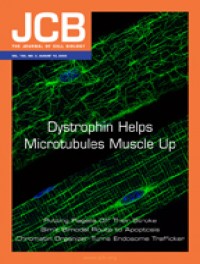Journal of Cell Biology Q1 Unclaimed
Journal of Cell Biology (JCB) is a broad journal that publishes original findings on all aspects of cell biology. We consider papers reporting new cellular or molecular advances in any areas of basic cell biology as well as papers that describe applied cell biology in a variety of systems including, but not limited to, immunology, neurobiology, metabolism, virology, developmental biology, and plant biology. We welcome all submissions that describe new findings of significant interest to cell biologists, regardless of the experimental approach. It has an SJR impact factor of 3,359.
Journal of Cell Biology focuses its scope in these topics and keywords: cell, protein, activation, receptor, actin, cells, expression, localization, membrane, nuclear, ...
Type: Journal
Type of Copyright: CC BY
Languages: English
Open Access Policy: Open Choice
Type of publications:
Publication frecuency: -


4524 €
Inmediate OANPD
Embargoed OA0 €
Non OAMetrics
3,359
SJR Impact factor422
H Index255
Total Docs (Last Year)805
Total Docs (3 years)15279
Total Refs4737
Total Cites (3 years)761
Citable Docs (3 years)5.08
Cites/Doc (2 years)59.92
Ref/DocOther journals with similar parameters
Cell Stem Cell Q1
Molecular Cell Q1
Cell Research Q1
Annual Review of Plant Biology Q1
Nature Cell Biology Q1
Compare this journals
Aims and Scope
Best articles by citations
THE USE OF LEAD CITRATE AT HIGH pH AS AN ELECTRON-OPAQUE STAIN IN ELECTRON MICROSCOPY
Identification of programmed cell death in situ via specific labeling of nuclear DNA fragmentation.
Extracellular vesicles: Exosomes, microvesicles, and friends
HIGH-YIELD PREPARATION OF ISOLATED RAT LIVER PARENCHYMAL CELLS
A SIMPLIFIED LEAD CITRATE STAIN FOR USE IN ELECTRON MICROSCOPY
Normal keratinization in a spontaneously immortalized aneuploid human keratinocyte cell line.
Preparation of separate astroglial and oligodendroglial cell cultures from rat cerebral tissue.
Parkin is recruited selectively to impaired mitochondria and promotes their autophagy
CYTOCHEMISTRY AND ELECTRON MICROSCOPY
Staining of Tissue Sections for Electron Microscopy with Heavy Metals
JUNCTIONAL COMPLEXES IN VARIOUS EPITHELIA
p62/SQSTM1 forms protein aggregates degraded by autophagy and has a protective effect on huntingtin-induced cell death
Disruption of epithelial cell-matrix interactions induces apoptosis
The extracellular matrix: A dynamic niche in cancer progression
Novel cell death program leads to neutrophil extracellular traps
Transfer of proteins across membranes. I. Presence of proteolytically processed and unprocessed nascent immunoglobulin light chains on membrane-bound ribosomes of murine myeloma.
VEGF guides angiogenic sprouting utilizing endothelial tip cell filopodia
QUANTITATIVE STUDIES OF THE GROWTH OF MOUSE EMBRYO CELLS IN CULTURE AND THEIR DEVELOPMENT INTO ESTABLISHED LINES
FINE STRUCTURAL LOCALIZATION OF A BLOOD-BRAIN BARRIER TO EXOGENOUS PEROXIDASE
Occludin: a novel integral membrane protein localizing at tight junctions.
Impairment of starvation-induced and constitutive autophagy in <i>Atg7</i>-deficient mice

Comments